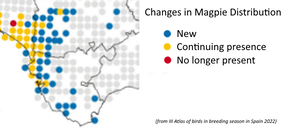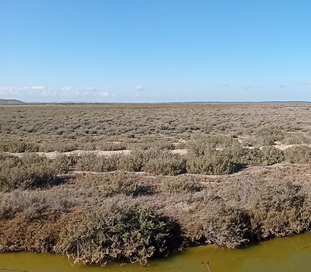

| Birding Cadiz Province |
|
|
No visit to this part of Spain, particularly in late spring, is complete without a look around the Trebujena area for Rufous Bushchat. It's a species in serious decline with a 95% reduction in numbers across the country, extinction in Granada and nearly so in Alicante and Murcia (98% reduction). Fortunately, as I've noted before a good population persists in the vineyards around this small town. I wasn't absolutely confident that I'd see one on my fist visit here this spring on 03/05 as birds sometimes arrive as late as June. Happily, I found a singing bird at the first place I checked (which was about 400m from where I'd had a pair with young last autumn). A check at the latter site was unproductive but a look at a third location produced a second bird.  My second visit to Trebujena was on 07/05 for another iconic and even trickier species to see in this area - Pin-tailed Sandgrouse. So tricky, in fact, that I'd only seen them once myself (although that's partly because Liz was always reluctant to get up early enough or stay late enough to give a good chance of seeing this species which tends to be most active at dawn and dusk). That said, I've known keen birders who've tried to find them multiple times without any luck. A few days before my visit, I'd tipped off a young Dutch birder, Danny Bregman, where to look and was somewhat miffed to hear that he then saw a couple on his first attempt! Hence I was up before first light to drive up to the area north of the A471 and c4km west of Trebujena where he'd seen them. It's a good area so I wasn't surprised to find Short-toed Lark, Montagu's Harrier, Spoonbill, etc with relative ease but what was a surprise was an adult Great-spotted Cuckoo happily feeding along the track! As this is largely a migrant in Cadiz province (and at a time I'm often back in the UK), I don't often see them and this bird treated me to my best views of the species. A 'result' but not the one that I expected. (NB - This saved me a trip to the area north of Puerto Real (Las Aletas) where the species now seem to be regular visitors, perhaps related to the increase in the Magpie, which they parasitise, in that area.  Excellent although it was to catch up with the cuckoo, I still hadn't seen any sandgrouse. I searched for another hour or so without any luck and as the habitat didn't look quite so good as that at Cortijo de Alventus (NW of Trebujena and c1km from the Guadalquivir). I knew that they were present in that area as I'd missed them by minutes in March. So 15 minutes later, I was just getting out of my car on the track by the cortijo when I espied a distant flock of twenty-plus sharp-winged fast flying birds. I quickly got my binoculars on them and, despite the distance, the two birds I concentrated on were clearly Pin-tailed Sandgrouse! In fact, to my great surprise, I could even hear their distinctive gaaa-gaaa call (hence the Spanish name Ganga). I didn't really take in what all the birds were but twenty seemed an awful lot for this scarce species, so I kept scanning for a more conclusive view. However, all I could find were flighty flocks of Grey Plovers (at least 60 and probably more), some in summer plumage, some in winter plumage and many moulting between the two. Sandgrouse resemble Golden/Grey Plovers in flight and the birds I saw were very distant so after fifteen minutes the doubts started to creep in - had I really seen them or was I just desperate to see them? Could I really have heard their gaaa-gaaa call at that range or was it me who was going gaga? I was on the brink of discarding the record as the result of delusional overenthusiasm when I heard a much louder gaaa-gaaa, looked up and had two Pin-tailed Sandgrouse fly right above my head before zooming off towards the site I'd first tried. Phew! With hindsight I think that, although I'm confident that I did see two birds earlier, I probably heard closer birds which I failed to see. I've since discovered via e-Bird that the following day two other observers, Faustino Chamizo Ragel & Chúss Fernández Vélez, had 35 sandgrouse (plus 125 Grey Plovers) on the Marismas de Trebujena (which seems to be the generic name for the whole area). Hopefully, this, the highest count here for some years, may reflect the work in restoring the marismas in recent years. So, despite my pessimism perhaps that original flock were all sandgrouse after all! Buoyed up by my success and as it was still relatively early, I decided have another look for bushchats and then visit Marisma de Cetina on my way back to Alcala. This time, as I was arriving from the opposite direction, I tried my third RBC site first. When I got there I pulled off next to a minibus and just as I got out of the car a group of four birders appeared from the other side of the road. Speaking to their guide, Stefan Schlick, I discovered that they were from Oregon and had been looking, unsuccessfully, for Rufous Bushchat. What could I do other than show them where I'd seen the birds in the past? After a couple of false starts, we pulled off where I'd first seen one on 03/05. We got out of the vehicles and, as I pointed out where to look, the bird flew past us singing! Only having previously seen them sing from a perch, I hadn't realised that they also do so in flight! We all subsequently had fantastic 'scope views! Brilliant stuff! It transpired that Stefan had used an old version of my site guide in planning his trip so he asked me where his group might see Red-knobbed Coot and some waders. I suggested Laguna de Medina for the first and Marisma de Cetina - which he'd never heard of - for the second. My offer to show them both sites was quickly taken up but first the group kindly insisted on buying me lunch. Medina proved to be a disappointment but Cetina delivered the waders some of which (Dunlin, Grey Plover, etc) are commonly found in America but others like Little Stint and particularly Lapwing were most appreciated. The Little Gull I'd seen here previously was also present amongst the Slender-billed Gull. More expected were Lesser Short-toed Lark which they hadn't seen previously. Showing people the delights of the area and a clutch of new birds was a bonus and a delightful way to spend my day ... without actually changing any of my plans!
0 Comments
Leave a Reply. |
About me ...Hi I'm John Cantelo. I've been birding seriously since the 1960s when I met up with some like minded folks (all of us are still birding!) at Taunton's School in Southampton. I have lived in Kent , where I taught History and Sociology, since the late 1970s. In that time I've served on the committees of both my local RSPB group and the county ornithological society (KOS). I have also worked as a part-time field teacher for the RSPB at Dungeness. Having retired I now spend as much time as possible in Alcala de los Gazules in SW Spain. When I'm not birding I edit books for the Crossbill Guides series. CategoriesArchives
May 2023
|